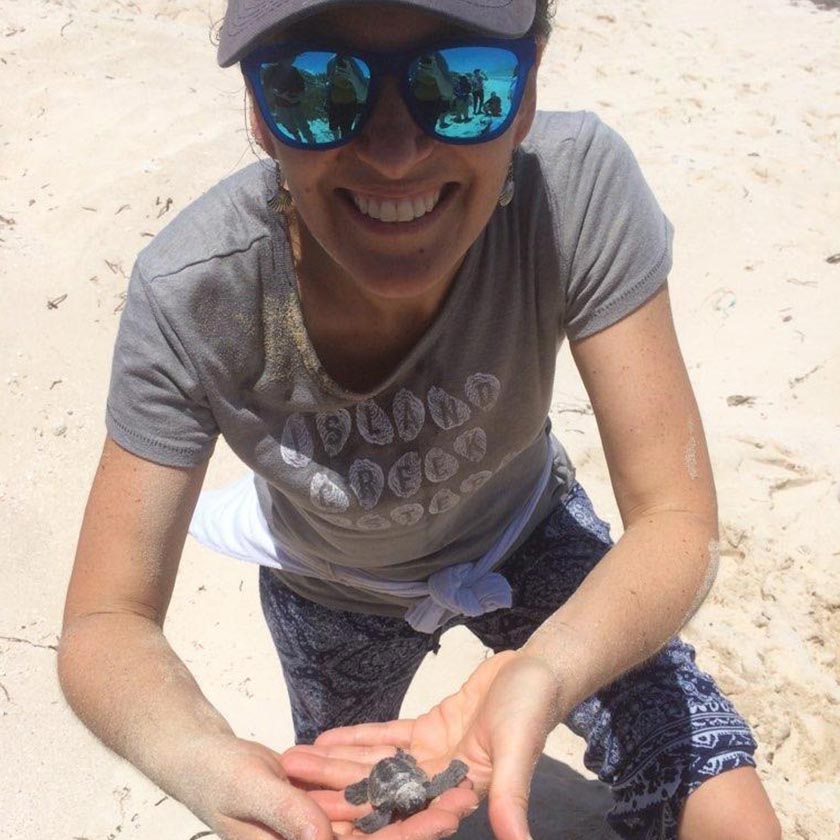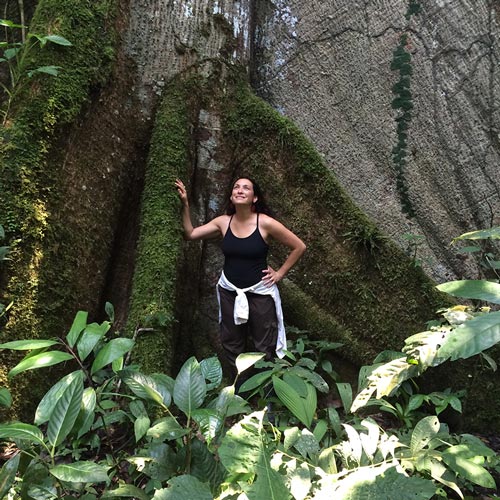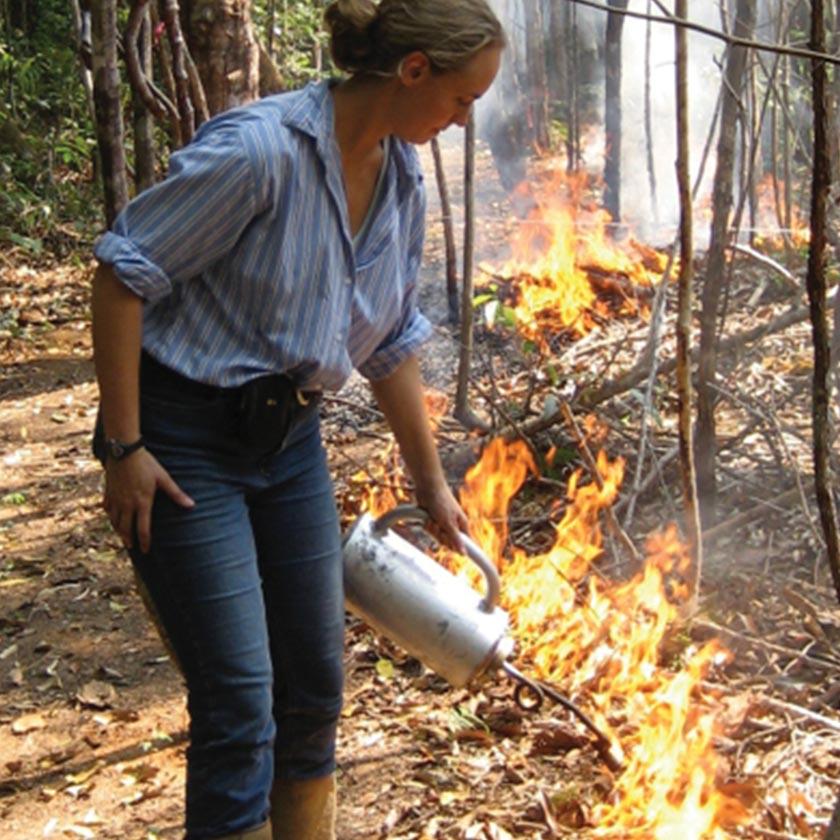For Lynn Scarlett ‘70, MA ‘73, a career protecting the environment began in her own backyard
Interview//Andy Levinsky Photos//The Nature Conservancy
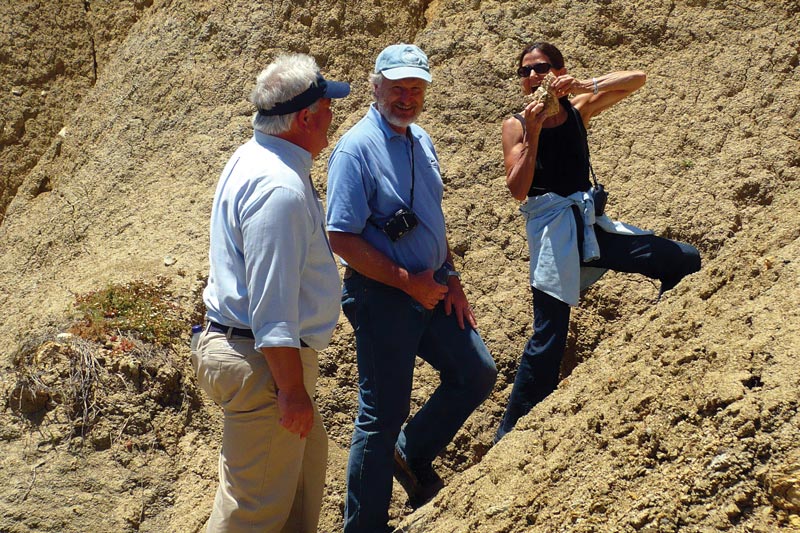
Scarlett at Santa Rosa Island--Channel Island National park with mammoth tooth.
What is the ideal path to becoming a leading environmentalist? For Lynn Scarlett, who served as U.S. Deputy Secretary of the Interior and is currently Vice President of Policy and Government Relations at The Nature Conservancy, it began with 27 acres of woods behind her childhood home. Growing up in a suburb of Pittsburgh, Pennsylvania, she found it“a place for endless exploration” that “formed my passion for nature.”
It helped to have a mother “who knew the names of all the plants, was a birder who took us out with binoculars to observe wrens and warblers and woodpeckers—and more—as soon as we could wield the binoculars. I was maybe 6 or 7 years old when we first ventured forth with binoculars. I learned all the birds of our area by age 8 or 9—and their songs and habits.”
In her teens, Scarlett became a competitive swimmer and spent two summers at a training camp 200 miles north of Toronto. “Beyond the daily swimming workouts, we canoed, sailed, camped on little islands among the many lakes, and hiked miles and miles,” she recalls. “We even did a 50-mile walk. I loved canoeing; I loved walking through the woods.”
When she came to Santa Barbara to attend UC Santa Barbara, Scarlett brought her binoculars to observe birds around the UCSB lagoon, along the beach, in the wetlands near the airport, and in the foothills.
After serving in the administrations of both George W. Bush and Barack Obama, Scarlett says her role at The Nature Conservancy felt like “a homecoming,” bringing this lifelong environmentalist’s career path full-circle.
If someone had asked you in high school what you wanted to do vocationally, what would you have told them?
Even in high school, I was keenly interested in public policy and political affairs. I think my interest at the time was driven mainly by a deep interest in justice—and a deep concern about injustices and poverty. This was the era of a growing civil rights movement—and, later, in college, of the Vietnam War. During high school, I tutored young African- American students in downtown Pittsburgh, where I saw the many disadvantages and prejudices they had to confront. These deeply affected me—and, I think, augmented my interest in public affairs. But
I had absolutely no idea whatsoever of what that interest might mean in terms of a career. I think, as I entered college, I had some vague notion that I might be interested in the Foreign Service because I liked traveling, languages, and public policy.
During your time as a student at UCSB, were you involved in environmental activities?
I was at UC Santa Barbara in 1969 at the time of the major oil spill, which sparked an enormous community reaction—and, eventually, was one of the events that really catalyzed the modern environmental movement. I helped clean birds that had become covered with oil, and I took part in several large events to draw attention to environmental challenges. But this was an era more significantly focused on the Vietnam War and protests against the war, and I, along with thousands of other UCSB students, were engaged in protesting the war.
Can you identify a specific professor, class, activity or experience at UCSB that sticks with you today?
Unquestionably, Michael Gordon, [professor in the political science department, 1965-2003] influenced me. He was incredibly insightful on international relations and on political economy. Particularly in graduate school, I relished his seminars. His influence ultimately sustained my interest in public policy and international relations, resulting in me going to the Geneva Institute of International Studies in Geneva, Switzerland, for graduate studies.
You came to the Department of the Interior as an environmentalist in the administration of George W. Bush. Were you concerned that you might be fighting an uphill battle given his allegiance to the business community that often had a competing agenda?
My primary policy focus, coming out of graduate school, was environmental policy. But I was particularly interested in the growing focus by people like former EPA Administrator Bill Ruckelshaus, on incentive-based environmentalism, advancing “beyond compliance” (in which the focus was mainly on meeting regulatory requirements rather than meeting—and moving beyond—those requirements). I had become interested in how to tap “local knowledge” of farmers, ranchers, workers, the fishing community, and others to link environmental and economic performance.
I had become interested in approaches to environmental progress that
measured actual performance (rather than equating having a permit or some specific piece of equipment as “success”). And I had become interested in how to motivate environmental action on complex issues such as mobile air emissions or waste management or farming, where the problems resulted from the actions of many—not just a set of companies and their smokestack emissions. This led me to write about performance-based, larger scale, incentive-focused (and even market-based) environmental policy tools.
When I came to the Interior Department, many in the Administration were also interested in these tools and in real environmental problem-solving. At Interior, we advanced what we called “cooperative conservation” to enhance policy tools and funding through which federal agencies could work in partnerships with ranchers, farmers, and other, as well as with state agencies, to enhance environmental investments and results.
Any Administration is filled with people of various interests and viewpoints, so some were clearly not focused on environmental issues as a priority (or even opposed certain regulations and investments and prioritized energy development or other economic actions). But there were also many who really embraced the concept of cooperative conservation, supported significant funding for conservation partnerships, and supported policy tools to enhance larger scale, collaborative conservation efforts.
Bottom line: there was lots of room to strive to advance some of the ideas I thought were critical to environmental protection. And there was one very big difference from today: I was able to work with the Secretary of the Interior to establish the first-ever Climate Change Task Force of over 100 scientists and other experts to assess the impacts of climate change on the lands, waters, wildlife and infrastructure managed by the Interior Department and to assess how the Department could reduce its own carbon footprint. In addition, informed by some very complex science, we were able to list the polar bear as threatened under the Endangered Species Act—the first such listing in which the primary threat to the species was the effects of climate change on the polar bear’s habitat.
"Many people think of the Conservancy in terms of this land trust work. However, over the past couple decades, we have broadened how we operate, engaging in partnerships with farmers, ranchers, fishing communities and others to help them incorporate sustainability practices into their land and resource management."
The Nature Conservancy is non-partisan. However, with specific issues such as climate change that put TNC at odds with the Trump administration, how do you straddle that line--remaining non-partisan while advancing issues that are TNC priorities?
Being nonpartisan pertains to how we engage on important issues and the style and voice that we bring to the issues—rather than on whether we engage on issues critical to advancing conservation, environmental protection, and sustainability. On issues of critical environmental importance, such as advancing vigorous climate change solutions or sustaining protections of endangered species, we weigh in on what solutions we think are essential (for example, national policies to price carbon emissions or sustaining habitat protections for endangered species) by providing relevant scientific analysis, information about why a particular policy will (or will not) bring expected environmental benefits, how certain solutions can help advance both economic and environmental benefits, etc. That is, we focus on providing relevant analysis of costs and benefits and implications for the public and environmental good of various policies. We do not focus on criticizing particular politicians and policy makers. We strive to build bipartisan coalitions of support for the policy positions we hold—such as our efforts in the US Congress to help create the Senate Bipartisan Climate Solutions Caucus.
There are also opportunities to advance concepts like natural infrastructure—investments in coastal restoration as a “better, cheaper, smarter” way of protecting coastal communities from storm surge— that have general bipartisan appeal, including among some in the current Administration. Often, seeking bipartisan solutions, we seek narratives that help “build communications and policy bridges”—for example, many of the policy ideas we advanced in the last Farm Bill were good for “nature” and also good for farmers, enhancing soil health and productivity while also enhancing biodiversity and water quality. Finding paths forward for constructive (and durable) solutions is, of course, not easy, and where we have deep concerns about specific policies, we strive to be assertive and clear, but with an emphasis on science, implications for people and nature, and long-term sustainability.
We’ve seen members of the Bush administration such as former EPA administrator Christine Todd Whitman who are outspoken in their criticism of President Trump. Do you share their concerns?
Consistent with my comments on framing nonpartisan engagement in policies (and our role as a nonprofit organization), the Conservancy does not engage in electoral politics and support or oppose particular politicians. That said, we have been very clear about our concern about specific decisions of the Administration—such as the decision to withdraw from the Paris Climate Agreement—or about certain decisions pertaining to wetlands and water protection, for example. There are many policies over the past several years—some promulgated by the Congress and some by the Administration—that the Conservancy has expressed concerns about.
How was your experience in the same role different under the Bush and Obama administrations?
I was a presidential appointee in the Bush Administration. Thus, my nearly 8 years (during
the two Bush terms) ended in January 2009, with the arrival of the Obama Administration. But I had very good relationships with the Obama team—at Interior, at the National Atmospheric and Ocean Administration, and other agencies. There was a lot that the Obama Administration undertook that was extremely aligned with the vision of cooperative conservation, large landscape conservation, and environmental performance that I had long thought was essential for a sustainable future.
What led you to your present role at TNC?
Upon leaving Interior in 2009, I became a Visiting Scholar at Resources for the Future, an environmental economics research institution, as well as participating in a number of projects relating to ecosystem services, climate change, the intersection of science and decision making, and large landscape conservation. All of these were topics very linked to The Nature Conservancy’s own vision and mission. Moreover, while at the Interior Department, with my focus on cooperative conservation, I interacted in the field across the nation with large numbers of collaborative conservation projects—and for virtually every one of them, the Conservancy was either a leader or key participant. Thus, I probably knew well over 100 Conservancy employees upon leaving the Interior Department.
In 2013, The Conservancy had begun to broaden its engagement in conservation policy and created a new role to lead this effort. Some people at the Conservancy reached out to me to see if I would be interested. The timing for me was great—and, ultimately, I was offered the role. It felt a bit like a homecoming—to an organization of people with conservation passions, deep commitment to science to inform decisions, and a long-standing commitment to collaborative conservation.
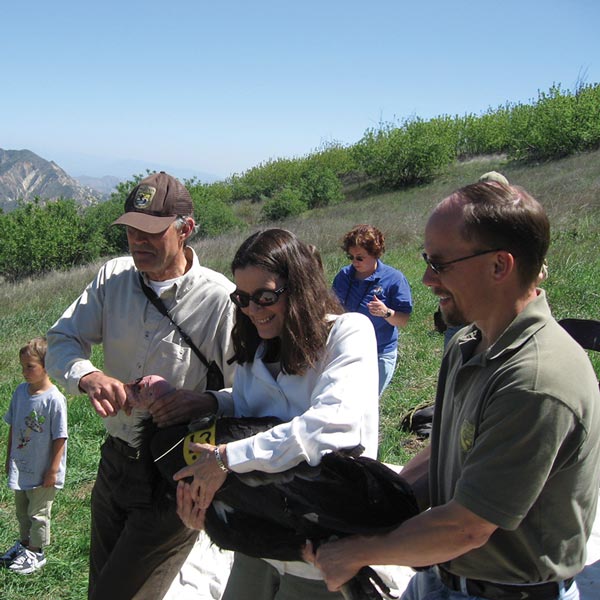
Lynn Scarlett releasing California condor into wild with Fish and Wildlife Service.
Any Administration is filled with people of various interests and viewpoints, so some were clearly not focused on environmental issues as a priority (or even opposed certain regulations and investments and prioritized energy development or other economic actions). But there were also many who really embraced the concept of cooperative conservation, supported significant funding for conservation partnerships, and supported policy tools to enhance larger scale, collaborative conservation efforts.
Bottom line: there was lots of room to strive to advance some of the ideas I thought were critical to environmental protection. And there was one very big difference from today: I was able to work with the Secretary of the Interior to establish the first-ever Climate Change Task Force of over 100 scientists and other experts to assess the impacts of climate change on the lands, waters, wildlife and infrastructure managed by the Interior Department and to assess how the Department could reduce its own carbon footprint. In addition, informed by some very complex science, we were able to list the polar bear as threatened under the Endangered Species Act—the first such listing in which the primary threat to the species was the effects of climate change on the polar bear’s habitat.
"Many people think of the Conservancy in terms of this land trust work. However, over the past couple decades, we have broadened how we operate, engaging in partnerships with farmers, ranchers, fishing communities and others to help them incorporate sustainability practices into their land and resource management."
The Nature Conservancy is non-partisan. However, with specific issues such as climate change that put TNC at odds with the Trump administration, how do you straddle that line--remaining non-partisan while advancing issues that are TNC priorities?
Being nonpartisan pertains to how we engage on important issues and the style and voice that we bring to the issues—rather than on whether we engage on issues critical to advancing conservation, environmental protection, and sustainability. On issues of critical environmental importance, such as advancing vigorous climate change solutions or sustaining protections of endangered species, we weigh in on what solutions we think are essential (for example, national policies to price carbon emissions or sustaining habitat protections for endangered species) by providing relevant scientific analysis, information about why a particular policy will (or will not) bring expected environmental benefits, how certain solutions can help advance both economic and environmental benefits, etc. That is, we focus on providing relevant analysis of costs and benefits and implications for the public and environmental good of various policies. We do not focus on criticizing particular politicians and policy makers. We strive to build bipartisan coalitions of support for the policy positions we hold—such as our efforts in the US Congress to help create the Senate Bipartisan Climate Solutions Caucus.
There are also opportunities to advance concepts like natural infrastructure—investments in coastal restoration as a “better, cheaper, smarter” way of protecting coastal communities from storm surge— that have general bipartisan appeal, including among some in the current Administration. Often, seeking bipartisan solutions, we seek narratives that help “build communications and policy bridges”—for example, many of the policy ideas we advanced in the last Farm Bill were good for “nature” and also good for farmers, enhancing soil health and productivity while also enhancing biodiversity and water quality. Finding paths forward for constructive (and durable) solutions is, of course, not easy, and where we have deep concerns about specific policies, we strive to be assertive and clear, but with an emphasis on science, implications for people and nature, and long-term sustainability.
We’ve seen members of the Bush administration such as former EPA administrator Christine Todd Whitman who are outspoken in their criticism of President Trump. Do you share their concerns?
Consistent with my comments on framing nonpartisan engagement in policies (and our role as a nonprofit organization), the Conservancy does not engage in electoral politics and support or oppose particular politicians. That said, we have been very clear about our concern about specific decisions of the Administration—such as the decision to withdraw from the Paris Climate Agreement—or about certain decisions pertaining to wetlands and water protection, for example. There are many policies over the past several years—some promulgated by the Congress and some by the Administration—that the Conservancy has expressed concerns about.
How was your experience in the same role different under the Bush and Obama administrations?
I was a presidential appointee in the Bush Administration. Thus, my nearly 8 years (during
the two Bush terms) ended in January 2009, with the arrival of the Obama Administration. But I had very good relationships with the Obama team—at Interior, at the National Atmospheric and Ocean Administration, and other agencies. There was a lot that the Obama Administration undertook that was extremely aligned with the vision of cooperative conservation, large landscape conservation, and environmental performance that I had long thought was essential for a sustainable future.
What led you to your present role at TNC?
Upon leaving Interior in 2009, I became a Visiting Scholar at Resources for the Future, an environmental economics research institution, as well as participating in a number of projects relating to ecosystem services, climate change, the intersection of science and decision making, and large landscape conservation. All of these were topics very linked to The Nature Conservancy’s own vision and mission. Moreover, while at the Interior Department, with my focus on cooperative conservation, I interacted in the field across the nation with large numbers of collaborative conservation projects—and for virtually every one of them, the Conservancy was either a leader or key participant. Thus, I probably knew well over 100 Conservancy employees upon leaving the Interior Department.
In 2013, The Conservancy had begun to broaden its engagement in conservation policy and created a new role to lead this effort. Some people at the Conservancy reached out to me to see if I would be interested. The timing for me was great—and, ultimately, I was offered the role. It felt a bit like a homecoming—to an organization of people with conservation passions, deep commitment to science to inform decisions, and a long-standing commitment to collaborative conservation.
What do you find most people don’t know about the Nature Conservancy ?
I suspect few people realize that we are a global organization, operating in 79 countries across the Asia-Pacific Region, Africa, Latin America, Europe and North America. Also, for many years, we operated largely as a land trust, buying lands to preserve and protect those lands (and waters), either by retaining them as Conservancy preserves or by transferring them to entities like the National Park Service or the national wildlife refuge system. Many people think of the Conservancy in terms of this land trust work.
However, over the past couple decades, we have broadened how we operate, engaging in partnerships with farmers, ranchers, fishing communities and others to help them incorporate sustainability practices into their land and resource management. We do this sort of partnering around the globe, working with Masai tribes in Africa on sustainable grassland practices, or with communities along the Yucatan Peninsula coast on coral reef protections, or cities to expand tree canopy and natural systems into cities to better manage storm water, reduce urban heat and bring other benefits. I imagine many people are unaware of how closely we work with indigenous communities, supporting their efforts to maintain and sustain healthy lands, waters, and wildlife.
Read about related Natural Leaders
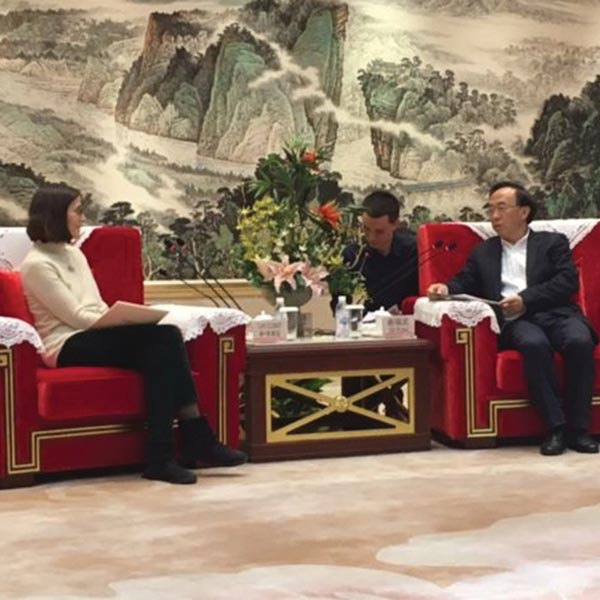
Scarlett at meeting in China on sustainability.
